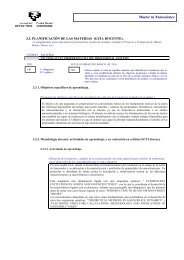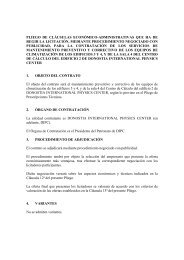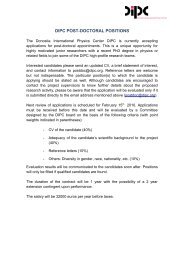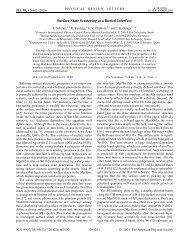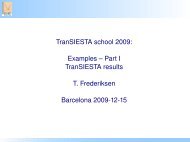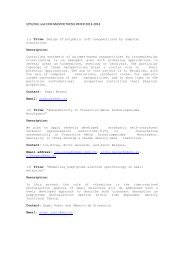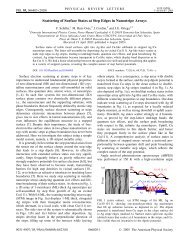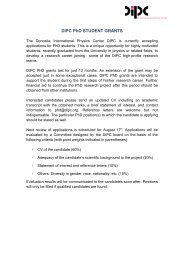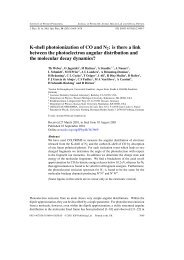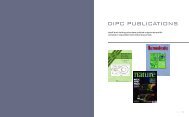Complete report - Donostia International Physics Center - Euskal ...
Complete report - Donostia International Physics Center - Euskal ...
Complete report - Donostia International Physics Center - Euskal ...
You also want an ePaper? Increase the reach of your titles
YUMPU automatically turns print PDFs into web optimized ePapers that Google loves.
2010 DIPC Highlight<br />
Mixed-valency signature in<br />
vibrational inelastic electron<br />
tunneling spectroscopy<br />
M. Alducin, D. Sánchez-Portal, A. Arnau, and N. Lorente<br />
Physical Review Letters 104, 165423 (2010)<br />
The unexplained vibrational inelastic electron tunneling spectroscopy (IETS) of O 2 on Ag(110) is<br />
now solved. When semilocal density functional theory is corrected by including static intraatomic<br />
correlations, the IETS simulations are in excellent agreement with the experiment. The<br />
projected density of states revels that when adsorbed along the [001] direction, O 2 on Ag(110) is<br />
a mixed-valent system, where a spin-polarized molecular orbital dominates the electronic structure<br />
at the Fermi.<br />
Inelastic electron tunneling spectroscopy (IETS) performed with the scanning tunneling microscope<br />
(STM) has given us unprecedented insight into the chemical structure of matter on the atomic scale. In<br />
the STM, electrons are tunneled through the vacuum gap between the tip and the substrate by applying<br />
them a bias voltage. Locating the tip over a single acetylene molecule adsorbed on a copper surface,<br />
Stipe, Rezaei and Ho showed that the tunneling electrons can give energy to the molecule and excite a<br />
particular vibrational mode. Since then, many experiments have confirmed the STM-IETS as a unique technique<br />
in which the vibrational spectra of individual adsorbates can be recorded by varying the tip-substrate<br />
voltage and used it as a fingerprint to identify the adsorbed species.<br />
In general, the IETS signal corresponds to an increase of the STM conductance just at the energy threshold<br />
of the vibration because the excitation of a vibrational mode opens an additional channel for conduction.<br />
Interestingly enough, experiments performed for oxygen molecules adsorbed on a silver substrate showed<br />
that this picture, i.e., the conductance increase, does not apply in this case. Specifically, when the molecules<br />
are chemisorbed along the [001] direction on Ag(110) instead of increasing, the current decreases<br />
at the vibrational threshold of the stretching mode. These experiments had remained unexplained during<br />
years, since all the most sophisticated IETS simulations done on this system had been unable to reproduce<br />
the conductance decreases.<br />
The IETS simulations performed by researchers at the DIPC that were published in Physical Review Letters<br />
have solved this long-standing puzzle. When semilocal density functional theory is corrected by including<br />
static intra-atomic correlations (DFT+U), the IETS simulations are in excellent agreement with the experiment.<br />
The analysis of the projected density of states shows that intra-atomic correlation leads to the spin<br />
splitting of the g orbital and the subsequent pinning of one of these orbitals to the Fermi level. The unforeseen<br />
consequence of our calculations is that when adsorbed along the [001] direction, O 2 on Ag(110)<br />
is a mixed-valent system in which a localized spin polarized orbital is at resonance with the Fermi level.<br />
The corresponding electronic structure leads to IETS simulations where the experimental change in conductance<br />
and also their spatial tip-position dependence are finally explained. The theoretical results give<br />
unprecedented information on the electronic and vibrational symmetries at work in this system. Importantly,<br />
these calculations also show that IETS can reveal important information about the electronic structure<br />
and magnetic nature of chemisorbed molecules. In this respect, IETS arises as a promising tool to<br />
characterize the otherwise elusive molecular mixed-valency regime. In this regime, electron correlations<br />
are responsible of large charge fluctuations between the adsorbate and the substrate that may lead to<br />
strong non-adiabatic effects dominating the adsorption dynamics.<br />
Figure 1. Spin-up (positive) and spin-down (negative) projected density of states of O 2 chemisorbed<br />
along the [001] direction. (a) Semilocal DFT (GGA) results. (b) Semilocal DFT+U (GGA+U) results.<br />
STM operating in IETS mode arises as a promising tool to characterize<br />
the otherwise elusive molecular mixed-valency regime.<br />
Figure 2. Semilocal DFT+U simulations of the spatial<br />
distributions of the conductance changes for the<br />
O-O stretch mode (left )and the antisymmetric<br />
O 2 /Ag mode (right).<br />
The unforeseen consequence<br />
of these calculations is that<br />
when adsorbed along the<br />
[001] direction, O 2 on Ag(110)<br />
is a mixed-valent system.<br />
38 DIPC 10/11<br />
DIPC 10/11 39



